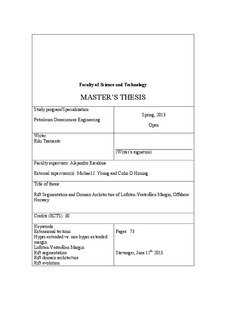| dc.description.abstract | The Lofoten-Vesterålen margin (LVM) is located in the offshore northern Norway. It is the least explored and understood margin within the Norwegian passive margin due to the authority’s restriction, which closed this margin for petroleum exploration. Several published geologic studies for the LVM, proposed different models for margin architecture of the LVM. The first model by Tsikalas et al. (2001), divided the LVM margin into three rift segments: Lofoten, Vesterålen and Andøya segment separated by transfer zones. The second model by Bergh et al. (2007) questioned the existence of lateral segmentation by the transfer zones and proposed that the lateral segmentation was caused by a temporal and spatial initiation of the faults families. The third model was suggested by Færseth (2012), proposed that the LVM consists of two rift segments bounded by an accommodation zone without any strike-slip motion.
This study utilize 2D seismic, well data, onshore outcrop and a set of gravity-magnetic data in order to further investigate the rift segmentation, rift evolution and domain architecture across the margin.
In this study, three rift segments are defined (South Lofoten, North Lofoten and Vesterålen-Andøya) and a model called progressive rift segmentation is proposed, whereby segmentation occurred during Early Cretaceous and Late Cretaceous within the LVM. The first segmentation is marked by the opposing fault polarity between each rift segments, while the second segmentation is characterized by a unique type of deformation consisting of Jurassic-Late Cretaceous fault decoupling. This later type of deformation does not appear to have observed within the other area in the Norwegian passive margin.
The rift evolution of LVM consist of pre-rifting/marginal rifting event during Triassic and Jurassic, shown by the localize distribution of wedge shape sedimentary package, main-rifting event during Early Cretaceous and post-rifting event during Late Cretaceous to present.
Furthermore, in this study the LVM is classified into three distinct rift domains: Proximal, Necking and Oceanic. Each of these domains consistently shows prominent structural similarities across the margin. The observation also reveals the difference of the rift domain architecture between lower-plate (hyper-extended) margins to the upper-plate (non-hyper-extended) margins. The lower-plate (hyper-extended) margins is characterized by the presence of Proximal, Necking, Distal, Outer and Oceanic domain, while within the upper-plate (non-hyper-extended), no Outer and Oceanic domain are observed.
Finally, a remarkable correlation of the Necking domain to the petroleum province within the Vøring margin hints the significance of rift domain characterization within passive margin setting. The Necking domain in the Vøring margin is interpreted to be favored by all of petroleum system element to work and preserve the hydrocarbon. The different characteristic of the Necking domain in the LVM to the Vøring margin degrade the likely-hood of the same petroleum play may exist (e.g., Jurassic play). Although, seismic interpretation and well data observation reveal that the Lower and Upper Cretaceous play may have greater potential for the LVM. | no_NO |
